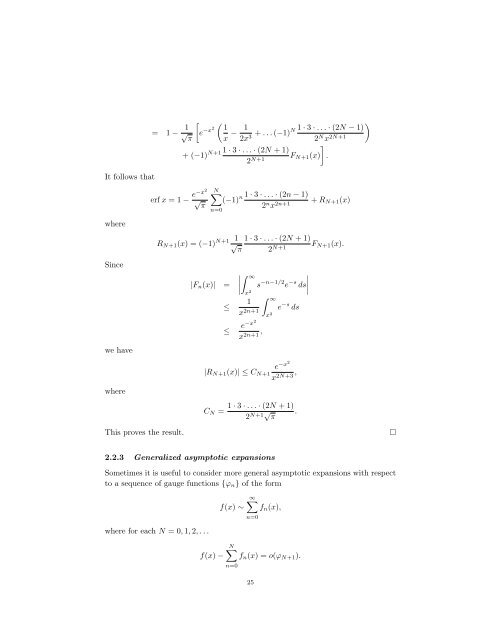Asymptotic Analysis and Singular Perturbation Theory
Asymptotic Analysis and Singular Perturbation Theory
Asymptotic Analysis and Singular Perturbation Theory
You also want an ePaper? Increase the reach of your titles
YUMPU automatically turns print PDFs into web optimized ePapers that Google loves.
It follows that<br />
where<br />
Since<br />
we have<br />
where<br />
= 1 − 1<br />
<br />
√ e<br />
π<br />
−x2<br />
<br />
1<br />
x<br />
erf x = 1 − e−x2<br />
√ π<br />
1<br />
1 · 3 · . . . · (2N − 1)<br />
− + . . . (−1)N<br />
2x3 2Nx2N+1 N+1 1 · 3 · . . . · (2N + 1)<br />
+ (−1)<br />
2N+1 <br />
FN+1(x) .<br />
N<br />
n 1 · 3 · . . . · (2n − 1)<br />
(−1) + RN+1(x)<br />
n=0<br />
N+1 1<br />
RN+1(x) = (−1) √<br />
π<br />
|Fn(x)| =<br />
≤<br />
<br />
<br />
<br />
<br />
2 n x 2n+1<br />
1 · 3 · . . . · (2N + 1)<br />
2N+1 FN+1(x).<br />
∞<br />
x2 s −n−1/2 e −s ds<br />
∞<br />
1<br />
x 2n+1<br />
≤ e−x2<br />
,<br />
x2n+1 x 2<br />
e −s ds<br />
e<br />
|RN+1(x)| ≤ CN+1<br />
−x2<br />
,<br />
x2N+3 CN =<br />
1 · 3 · . . . · (2N + 1)<br />
2N+1√ .<br />
π<br />
This proves the result. <br />
2.2.3 Generalized asymptotic expansions<br />
Sometimes it is useful to consider more general asymptotic expansions with respect<br />
to a sequence of gauge functions {ϕn} of the form<br />
where for each N = 0, 1, 2, . . .<br />
f(x) −<br />
f(x) ∼<br />
∞<br />
fn(x),<br />
n=0<br />
N<br />
fn(x) = o(ϕN+1).<br />
n=0<br />
25
















